Water leakage sensor: how to choose and install an anti-flood system with your own hands
Failure of plumbing fixtures is one of the most common causes of leaks.Agree, being the culprit of a flood and its victim is both unpleasant and financially expensive.
A timely installed anti-flood system will help avoid disaster even in the event of damage to pipes and disruption of the integrity of the water circuit. Before installing a water leakage sensor with your own hands, you need to understand the structure of the mechanism and the operating features of different models.
We will talk about the design features and operating principle of the device. Let's explain the assembly procedure protective system and controller connections. Visual photo instructions and thematic videos will help you choose a device and install it yourself.
The content of the article:
The principle of operation of the anti-leakage system
The operating principle of any stationary “anti-leakage” system is based on the difference between the electrical conductivity of water and air. The basis of any sensor is a regular pair of electrodes.
If water gets on them, the resistance decreases and the electrical circuit closes. Information about the circuit closure is sent to the controller, where the pulse is deciphered and the information is processed.
After this, the controller gives its signal to close solenoid valvelocated on the riser, directly at the input itself.
The inlet valve will be closed until the cause of the leak is identified and completely eliminated.After performing simple manipulations with the controller, system operation will be resumed.
The stationary system operates autonomously and requires intervention only if a leak is detected and faults are eliminated.
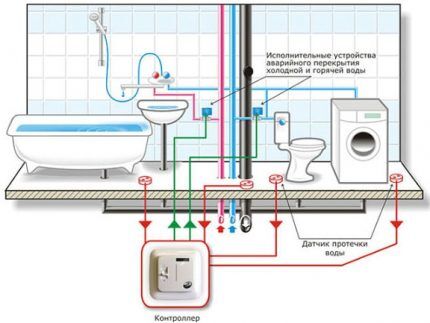
Classification of leakage protection systems
Anti-leakage systems are classified according to the following main characteristics:
- By the number of electric taps included.
- According to the method of reporting a leak.
- According to the method of information exchange between sensors and the control unit.
As a rule, the number of electric cranes in a set should be at least two. This is due to the fact that taps must be installed on cold and hot water risers. The number of taps, depending on the chosen system, can be increased.
Types of models by notification method
There are the following ways to report a leak:
- indication on the controller display;
- indication on the display accompanied by noise signals;
- noise alarm, indication and message sending.
Message transmission is possible if the system is equipped with a GSM transmitter. In this case, an SMS message is sent to a phone number that is stored in the device’s memory.
The phone number is entered from the control panel. When the system is connected to the Internet, it is possible to send messages via a GPRS connection.
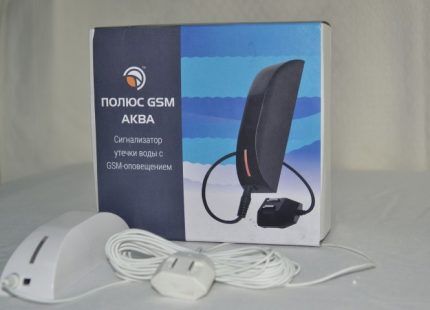
The information displayed on the control panel varies depending on the model. Most often, information is displayed about the presence of leaks, the status of sensors, and the charge level of batteries and batteries.
Wired and wireless sensors
Signals from water leakage sensors can be transmitted to the controller, both via wires and radio channels. In this regard, it is customary to distinguish between wired and wireless systems aimed at preventing flooding.
In wired systems To transmit information, a voltage of up to 5 V is supplied to the sensor. In the case of a dry surface, there is no current due to the high resistance between the contacts. As a result of exposure to moisture, the resistance decreases and the current increases.
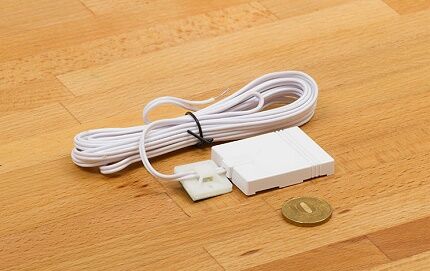
To eliminate false alarms, you need to set the minimum current threshold at which the controller will close the solenoid valves.
This is due to the fact that the resistance between the contacts decreases when steam is generated or water is sprayed, but its value remains quite high and does not reach minimum values, as as a result of a leak.
Inside everyone wireless sensor There is a current comparison circuit that is triggered when the set value is reached. A special transmitter constantly measures the contact resistance and, in the event of flooding, immediately sends a radio alarm signal to the receiver. The receiver and transmitter are tuned to the same frequency.
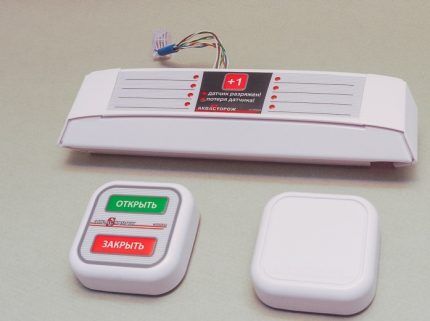
The transmitter signal is modulated to avoid false alarms due to electromagnetic interference.
Each manufacturer uses its own modulation principles. In this regard, wireless water leakage monitoring sensors cannot be used in other leakage monitoring systems.
Typical configuration of the protective system
The following leak alarm systems, operating on the same principle, have gained the most popularity among consumers:
- Neptune;
- Aqua watchman;
- Hydrolock.
The presented systems use Ball Valves with solenoid or electromechanical valve with a diameter of ½, ¾, 1 inch. The devices not only ensure that the tap is turned off, but also inform about a leak.
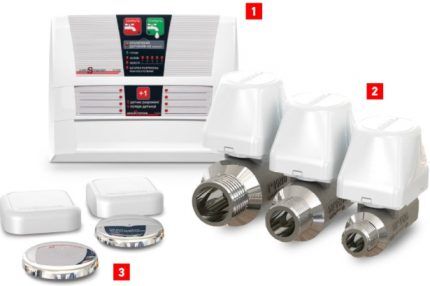
Water leakage systems can be integrated with "Smart Home" systems.
The leakage protection package includes:
- Ball Valvesequipped with electric drive. They are designed to completely or partially block water supply or heating circuits in case of leakage. The device is mounted directly after the inlet valves.
- Controller, which is a control unit. Designed to perform just one operation - closing the electric tap after receiving and processing a signal from one of the sensors. In addition, the controller is responsible for notifying about leaks and powering the sensors.The controller can be installed in any convenient, yet accessible place.
- Leak sensors. When moisture gets in, a leak signal is given. Connect exclusively to safe energy sources. Sensors are installed in places that most often threaten leaks: under shower stalls and sinks, behind toilets, near washing machines, in places where flexible hoses are connected, etc.
Sensors can be autonomous, as in a system Hydrolock, and volatile, both in cheaper protection "Neptune".
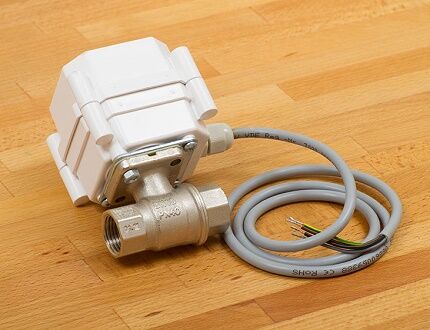
In autonomous water supply systems, the function of an electric faucet can be performed by a pump, which turns off after receiving a signal from the sensor about a leak. But even in this case, it is undesirable to neglect the installation of a ball valve equipped with an electric drive.
Even if the pump turns off and the water supply from the wells or wells, then in the absence of a shut-off inlet ball valve, complete protection of the system from leakage will not be provided.
This is due to the fact that water may enter a faulty system from hydraulic accumulator. Therefore, installing a “controlled crane” is considered a necessity.
Rules for installing an anti-flood system
The main advantage of any modern leakage protection system is its ease of assembly and speed of installation work. By purchasing a flood warning system, you receive a kind of construction kit, the individual parts of which are connected using special connectors.

Work on installing the system should begin by drawing up a detailed diagram, which will clearly indicate the location of each of the component parts. After developing the plan, it is necessary to check the length of the wires and determine whether it is sufficient to connect sensors and taps to the control unit.
Installation work is carried out in the following order:
- Marking areas where the controller, taps and sensors are to be installed.
- Laying and connecting installation wires.
- Insertion of ball valves equipped with shut-off valves with electromechanical or electromagnetic drives.
- Installation of leakage sensors.
- Installation of the control unit (controller).
- Connection and testing.
One of the most difficult aspects of installing leakage protection is inserting ball valves. An error when inserting taps can ruin all efforts.
Ball valve insert
Before carrying out work, you need to turn off the taps located at the entrances of the cold and hot water risers. Next, directly behind the tap, you should cut the pipeline and carefully hot and cold water meters - the seals must remain intact.
After this, you need to screw the system valve onto the faucet or onto a pre-installed outlet. Now it remains back install counter and reconnect the previously removed pipes.
The complexity of the work depends on the type of pipes of the water supply or heating system. The easiest way to work with metal-plastic pipes is just to connect the elements and press them with a lock nut.
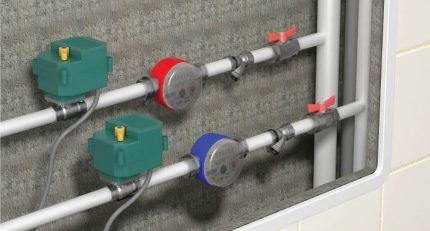
If the water supply or heating system is made of propylene pipes, then complex soldering can be replaced by using special detachable couplings used for repair purposes.
After installing the taps, you need to connect them with a separate power line to the controller distribution box, which provides power to the shut-off unit.
Installation of water leakage sensors
Installing water leakage sensors with your own hands should not pose any difficulties. Sensors should be located in places with a high risk of leaks:
- under showers and bathtubs;
- behind sinks and washbasins;
- near toilets, washing machines and dishwashers.
If the floor has a slope, then the sensor must be installed in the lowest place.
There are two sensor layouts:
- internal;
- floor
Manufacturers recommend giving preference to the internal placement of sensors, in which the devices are embedded in tiles or other floor coverings.
Internal layout. The contact plates of the sensor must be brought out and placed 3-4 mm above the floor level. This arrangement will prevent false operation of the system in the event of wet cleaning or accidental splashing of water. The wire to the sensors is supplied in a waterproof corrugated pipe.
External location. The sensors are placed directly on the floor with the contacts down. The sensor body can be fixed using construction adhesive or double-sided tape.
The external arrangement of devices is most often used if the leakage control system is installed after the finishing and installation of plumbing has been completed.
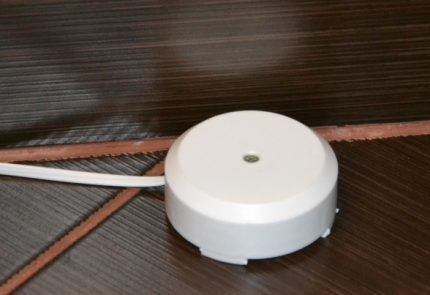
Installing a water leak sensor yourself will cause even less difficulties if the system has wireless sensors.
In this case, you don’t have to worry about the aesthetic side of the issue; you don’t need to ditch the walls and floor or disguise the wires in the baseboard. The wireless sensor can be easily mounted on any surface, as it is equipped with fasteners.
Controller installation rules
The controller should be located in a place convenient for maintenance. It is best to place the controller near shut-off valves; it can be mounted on the wall using brackets or hidden in a niche.
Please note that the power supply to the control unit is provided by the power cabinet, so phase and neutral must be connected to the controller.
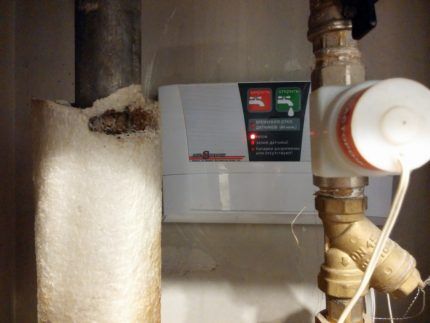
After securing the controller, you can connect it to the electrical network and connect electrically controlled valves.
The wires are connected through special terminal connectors, numbered and labeled for ease of installation. The controller and the instructions clearly indicate where and which wire should be connected.
All that remains is to connect the water leakage sensors to the appropriate connectors and the system assembly can be considered complete. If the standard length of the wire is not enough, then they must be extended. Manufacturers guarantee the operation of the system even if the sensor is 100 m away from the control unit.
Checking the system operation
After pressing the power button, the controller will conduct diagnostics and confirm its readiness for operation with a green indicator light. Before entrusting the security of your home to the system, it would be a good idea to diagnose it.
To do this, it is enough to moisten the plate of one of the sensors with water. If the system is working correctly, you will hear a beep, the indicator light will turn on or flash red, and the electric valves will shut off the water supply.
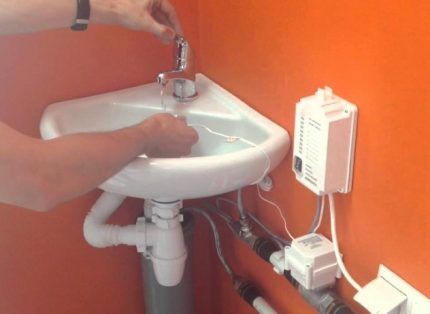
To unlock the system, the sensor should be wiped dry and reinstalled. The controller's power needs to be turned off and on again. After self-diagnosis, the water leakage control system is ready for operation again.
How to choose flood protection
In terms of efficiency, cheap and expensive devices are almost the same, with the exception of manufacturing defects that can be present in any system. Each manufacturer presents its product, but this is just advertising and nothing more.
In the leakage protection system with logo Hydrolock The complete delivery includes 3 sensors, while you can connect another 40 sensors without installing additional units.
Complexes protection Aqua guard initially equipped with 4 sensors and you can connect 10 more. If you install additional blocks, the number of sensors can be increased to 375.
Included system Neptune There are only 2 sensors, the rest must be purchased separately. Moreover, without installing additional units, the system can support no more than 10 water leakage sensors.
A wireless sensor system significantly increases the cost of the system, so if you are satisfied with a wired system, it is better to give preference to it. Also, the cost of the system increases if it is possible to install additional taps.
As we found out, for effective operation you need no more than 2 ball valves with solenoid valves mounted on cold and hot water risers behind the inlet valves. If you buy a system with 6-8 taps, you will overpay for something you will never use.
Some manufacturers, when advertising their products, speculate on such a value as operating voltage. And for protection systems it ranges from 5-12 V.
At the same time, the current strength in the sensor wires is absolutely safe, and the current strength in the faucet wires, although it reaches 1 A, lasts only a few seconds, so the difference in operating voltages is not at all significant.
One of the main indicators of system performance is the tap shut-off time. In cheap systems Neptune this figure reaches 30 seconds, while the most modern systems Aqua guard capable of turning off taps in just 2-3 seconds.
Please note that if heating or water pipes rupture, 20-25 liters of water can spill out in 30 seconds.
Another important indicator is the presence of a battery included in the kit, which ensures autonomous operation of the system in the event of a power outage.
Conclusions and useful video on the topic
Overview of the Neptune anti-leak system configuration and installation tips:
Review of the Aquaguard set:
Most protection systems against emergency water leaks are self-sufficient - they are capable of not only monitoring leaks, but periodically monitoring sensors, determining the battery charge level, and cleaning solenoid valves.
Modern anti-leakage systems are completely autonomous and require human intervention only to eliminate an accident.
Are you looking for an effective sensor to protect against leaks? Or do you have experience using such devices? Please leave comments on the article, ask questions and share your impressions of the use of anti-flood protection systems.




In general, such sensors are especially relevant in apartment buildings. However, I don't really condone the use of expensive valve coupled systems. Sometimes it is enough to use sensors that simply signal a leak. They are cheaper, and some of them can send an SMS message about a leak. At least here, the option of shutting off the water in the apartment is excluded in case you simply spilled water on the floor.
Sorry, I think just the opposite. In an apartment building, the use of expensive systems with water shutoff is very relevant and completely justified. How will it help you to hear that you have a leak while you are at work? This is complete stupidity in systems without shutting off the water. Price markup. Still, I think the installation should be trusted to specialists.
I agree with you. The target audience of such leakage sensors is wealthy people with a well-maintained apartment. In such a situation, saving on a sensor is not the smartest solution.
Even well-installed high-quality plumbing fixtures, taps and pipes are not immune from water hammer or absent-mindedness of the owner, who may simply forget to close the tap. There are quite a lot of options in which the system can save your property, as well as the property of your neighbors below. So taking such a system without ball valves makes little sense at all, in my opinion.
A nice bonus to this system is that many insurance companies give a discount on insurance for an equipped apartment.
Hello. Very useful indeed. You can call the management company and ask them to turn off the water. Until the reasons are identified, it is even beneficial for them, because if the examination shows that it is their department, there is no reason for them to make losses. And then come home from work, ask for time off and solve the problem. And if you don’t know, you can spend an 8-hour day and end up with significant losses.
Yes, yes, I went on a business trip for a couple of days and then the sensor signals “they say the flood is your master,” and when you arrive only tomorrow, you call the management company, “and cut off the water to the entire 16th floor for a couple of days, I’ll come and we’ll sort it out there!” and the house will sit without water wow-ha-hah! The residents will have a lot of fun...faucets with liquid valves in such a system are not a luxury, but a necessity! and leakage sensors installed without valves, just a funny tweeter with SMS notification and nothing more! Just like radio channel security systems... well, I received an SMS that the apartment was being robbed, so what? call the police? By the time they arrive, they will have taken everything out, even the chandeliers will have time to remove... and then the same system, everything should turn off on its own and block the water supply, and when you return there from a business trip/vacation then figure out what leaked and where?